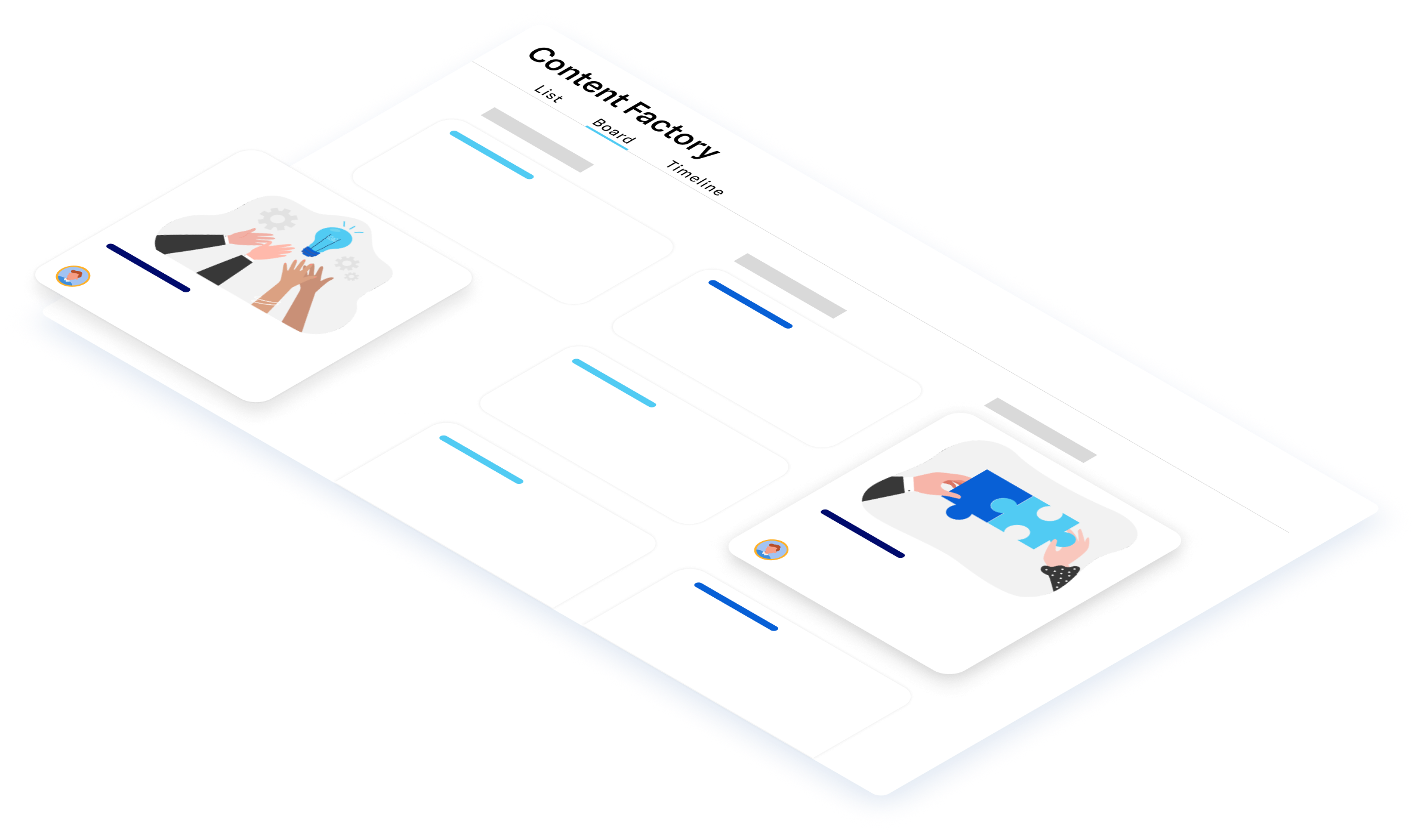
The Complete Guide to Content Marketing
Content marketing has become an essential tool for businesses. Eskimoz can help you create a high-value content strategy that meets your needs.

Understanding Content Marketing and Its Goals
So, what exactly is content marketing?
In essence, it’s a long-term strategy that focuses on drawing visitors to your website by providing valuable, informative, and relevant content to online users. Unlike traditional marketing methods, content marketing is non-intrusive and attracts consumers through the quality of information provided by your company or brand.
The main objective of a content strategy is to showcase your company’s expertise in your industry and address the needs of your target audience in a meaningful way.

Good to know
Content marketing is distinct from brand content marketing, which focuses on promoting products, while the former is customer-centric. In content marketing, the focus is not on what is being sold, but rather on what the company is doing for the customer and the benefits they can derive from it.
What is the relationship between content marketing and inbound marketing?
Content marketing is part of a broader approach called inbound marketing. In contrast to outbound marketing, inbound marketing involves naturally attracting potential clients and converting them into customers, without using aggressive or intrusive methods (unlike outbound, which uses techniques such as cold calling, invasive advertising, or street marketing). Prospective customers are acquired through tailored content, which requires an appropriate content marketing strategy. Other methods are then added to achieve desired objectives: SEO, SEA, nurturing, automation, etc.

Why is content marketing important?
Content marketing has become crucial because it meets the expectations of modern-day consumers. With the expansion of the internet and the rise in competitors, buyers have become more discerning and unpredictable.
Gone are the days when they would make purchases without any research. They now seek information, read customer reviews, interact with experts, and desire personalised messages. Content marketing is the optimal way to satisfy these new demands. By implementing a content strategy, a company/brand can increase its digital presence, show off its expertise and added value, and establish itself as an industry leader.
-
90%
of internet users
browse the web before making a purchase -
27m
pieces of content
are shared every day worldwide -
90%
of organisations
use content marketing
What content marketing can do for you
Content marketing helps build confidence in your brand
Implementing a content marketing strategy enables a company or brand to address the major commercial challenges of our time. In an era where consumption is heavily shifting to the web, digital visibility is no longer an option: it’s a necessity for any player wishing to gain market share or simply maintain their hard-won position. However, content marketing also has another fundamental virtue: it creates trust and, in doing so, fundamentally changes the relationship between the professional (who sells) and the consumer (who buys). As a result, it provides a multitude of benefits.


The benefits of content marketing
-
Visibility
Regularly publishing SEO-optimised content strengthens your digital presence by improving your visibility.
-
Traffic
High-quality content ranks higher on search engine results pages, driving more traffic to your company website.
-
SEO
The volume and quality of content produced in content marketing impact your SEO strategy. Creating high-quality content in large quantities helps to improve your website’s ranking.
-
Potential customers
Creating high-value content attracts qualified prospective clients to your website who are interested in your products or services and are more likely to contact your sales team.
-
Clients
Content marketing is part of a larger strategy aimed at converting potential leads into paying customers. Specific types of content are designed to optimise this crucial stage of the customer journey.
-
Leadership
With an effective content marketing strategy, you can demonstrate your expertise and position your company/brand as a leader in your industry and market, making you a key player in your field.
-
Awareness
By providing an excellent user experience through your content and sharing it on various digital platforms, you can develop your brand awareness and gain a significant competitive advantage.
-
Customer retention
Content marketing doesn’t end at the point of sale. It can continue to work by retaining customers, who may purchase additional products/services or become your brand ambassadors.
-
Longevity
Content marketing builds a long-lasting acquisition and conversion strategy that can continue to work for years, even if you stop producing content overnight.
-
95%
of internet users
exclusively view the first page of Google results. -
86%
of marketers
believe that content marketing is a performance lever. -
3
times
more leads are generated through content marketing
Content builds relationships. Relationships are built on trust. Trust drives revenue.

A strategy based on content creation
As the name suggests, it relies on a process of creating content that meets several criteria. Content should be relevant to the expectations of consumers, informative rather than promotional, provide advice and tips, and contain an emotional aspect that attracts attention and provokes emotion. Moreover, the term “content” is not limited to blog articles, newsletters, and other textual formats. Videos, infographics, and contests are also used to deploy efficient marketing by mixing types of content and formats.

The Types of Content Used in Marketing
Here are the primary types of content used in a content marketing strategy.
-
Blog articles
Blog articles, whether short or long, demonstrate your expertise on specific topics and strengthen your digital visibility when published on your company blog.
-
Whitepapers
These long and in-depth contents, also known as e-books, effectively demonstrate your expertise and are especially suitable for the conversion stage.
-
Case studies
By highlighting specific cases of your clients, you showcase your product or service’s benefits.
-
Surveys and polls
These formats are characterised by their pedagogical aspect, as they provide readers with insights into your area of expertise and positioning.
-
Landing pages
This highly specific type of content refers to the pages where visitors land when they click on links. They enhance conversions.
-
Testimonials
An interview format that can be either neutral (with an expert) or promotional (interviews of clients or employees).
-
Checklists
Highly appreciated, checklists serve as valuable organisational tools that grab the attention of visitors and encourage sharing.
-
Product sheets
Essential for e-commerce businesses, they serve as SEO boosters, landing pages, and informative content for potential customers.
-
Infographics
Visual content that provides clear information through an accessible format and requires limited attention, hence its strong potential for going viral.
-
Videos
Videos are easily consumable from any device. It’s no wonder that this is THE most popular content format!
-
Webinars
Online conferences (webinars) allow you to offer expertise through a format that encourages interactivity.
-
Podcasts
Increasingly present in content marketing, podcasts are significant vehicles for expertise and brand awareness for companies.
-
Slideshows
This conventional format is experiencing a digital renaissance in the form of PowerPoint presentations and SlideShare.
-
Newsletters
Newsletters remain one of the most appreciated formats for companies to follow up with prospects and retain customers.
-
Social media posts
This type of content covers all forms of posts on social networks (posts, tweets, live videos, Stories…).
-
Press release
Content dedicated to corporate communication that allows you to convey a message (news, reaction, promotion…) and boost visibility.
-
Templates
Templates are particularly popular with internet users looking for practical information. They are also valuable engagement drivers.
-
Games and quizzes
Entertaining content like quizzes and contests helps you collect strategic information and get to know your audience better.
Good to know
Content produced within a content marketing strategy must follow a set of rules: it must be adapted to the web (quick reading, consultation from mobile devices, limited attention span…) while respecting search engine requirements for indexing. Marketing content should be structured in a certain way (in an “inverted pyramid” where the most important information should appear first), use HTML tags, contain outbound links, etc.
The Key to Building a Successful Content Strategy
It’s not just about content, it’s about strategy
Content marketing relies on the creation of relevant and high-value content to capture the attention of prospective clients. But that’s not enough! Like any marketing strategy, a content-focused approach must take into account a number of factors, and its deployment must follow several fundamental steps. Without a well-established plan of action, you risk not reaping the rewards of your efforts and generating frustration due to a lack of results from your investments. Yes, content marketing has a cost, and therefore inevitably a return on investment!


How to create a content marketing strategy
Here are a few steps you need to follow:

-
STEP 1
Identify your target audience
To ensure the success of your content marketing strategy, you need to reach the right audience – those who will read your content. It’s therefore essential to start by identifying your targets and creating “personas”, i.e. profiles of your ideal potential customers, that you have in mind when choosing your topics.
-
STEP 2
Create content
Based on the topics that interest your targets, you will create content that addresses their issues, provides them with information, and subtly attracts their attention to your company/brand. This content varies according to the identified buying paths, but also according to the type of audience you are addressing (B2B or B2C).
-
STEP 3
Create a calendar
To ensure that your content strategy yields results, you need to adopt a regular posting rhythm and stick to it. Ideally, you should establish a writing and distribution calendar. This will enable you to know precisely who should write what, when, for which target audience, and on which channels.
-
STEP 4
Incorporate SEO
Creating content and optimising it for search engines go hand in hand. Optimised content helps increase traffic to your website and thus, your visibility. When you consider that 90% of internet users don’t go beyond the first page of Google search results, it gives you an idea of how important positioning is.
-
STEP 5
Promote your content
In content marketing, creating great content is only half the battle. The other half is ensuring that it’s seen by as many people as possible. This means promoting your content across multiple channels, including social media, newsletters, and other relevant platforms, to reach a wider audience and drive traffic to your website. After all, what’s the point of creating great content if no one sees it?
-
STEP 6
Measure performance
Like any marketing strategy, content marketing requires regular check-ins. In other words, you need to measure the performance of your marketing actions using relevant KPIs (traffic volume, bounce rate, conversion rate, number of downloads…) based on your activity, objectives, and target audience.
Found out how to write content optimised for SEO
Content marketing in B2B and B2C
B2C content marketing
- Short buying journey
- Novices/experts
- Blog articles, infographics, videos & fun content
- Accessible and educational language
- Single decision-maker and user
- Short-term customer relationship
- Decision-making based on emotion
- In tune with the benefits of enjoyment and engagement
- Facebook, Twitter, YouTube, Instagram
VS
B2B content marketing
- Long buying journey
- Knowledgeable experts/professionals
- Whitepapers, case studies, testimonials & surveys
- Technical and direct language
- Multiple decision-makers and users
- Long-term customer relationship
- Decision-making based on reason
- Sensitive to performance and profitability benefits
- LinkedIn, Twitter, YouTube
-
70%
of marketers
prioritise content quality over quantity -
51%
of companies
publish content daily -
62%
of organisations
outsource their content writing
Examples of successful marketing strategies
The huge diversity of content marketing
Content marketing is diverse and adaptable to all types of businesses and brands, in all sectors, and to any target audience. Strategies can be extremely varied, from the chosen formats, to the content on offer, to the preferred distribution channels, or even to the tone adopted to address audiences. In reality, anything is possible when it comes to content strategy: you just need to find the right way to communicate with your audience, the one that resonates with your company/brand and corresponds to its positioning.
To illustrate our point, we have selected four examples of successful content marketing strategies implemented by large brands, which are particularly inspiring.

4 examples of successful and inspiring content strategies
Content Marking Trends to Look Out For
Content marketing, a strategy of the future
Content marketing, like all digital approaches, is constantly evolving. The tools we use, the methods we employ, the platforms we leverage, and even the SEO algorithms we optimise are all subject to change. As our audiences become more discerning and demanding, implementing a successful content marketing strategy requires constant adaptability. Despite the challenges, 78% of marketers view content marketing as the future of their profession. It’s therefore crucial to remain vigilant and anticipate the major trends on the horizon, so that we can integrate them into our existing strategies and reach an ever-widening audience.


What will content marketing look like in the years to come?
-
Live video
The live video format is enjoying considerable success on social media, especially on Facebook and Instagram. It is likely to intensify and become a cornerstone of content strategies.
-
Audio content
Voice search is experiencing spectacular growth. Future content will have to adapt to this search mode by offering audio responses (podcasts and others).
-
Interactive content
Interactivity is a source of engagement and content is adapting (quizzes, contests, webinars and live videos…). This is a trend that is expected to quickly intensify.
-
User-generated content
UGC (User-Generated Content) is increasingly used by brands, and for good reason: user-generated content is a powerful generator of trust for consumers.
-
Personalised content
Effective audience segmentation will allow for maximum content personalisation to target specific audiences. Making each reader feel unique and special.
-
Long-form content
The “slow content” trend is gradually taking hold: longer and more in-depth content is replacing “snack content”. All for the benefit of consumers.
Our Commitment
-
Expertise
Since 2010, we have worked with over 2000 clients across 90 countries.
-
Passion
We are a team of passionate, industry-focused individuals who are committed to your success.
-
Performance
We’re committed to implementing a data-driven strategy, making a real impact on your bottom line by providing avenues for growth.
Any questions?
The answer depends on several parameters: your industry, the size of your company, the type of product/service you offer, the competition, the target audience of your content, and so on. It should be noted that you shouldn’t address prospective B2B and B2C clients in the same way, which requires offering different types of content.
When embarking on a content marketing strategy, there are numerous challenges to overcome: having the resources and skills in-house, managing your budget, constantly coming up with new ideas, and dedicating time and energy to it. Outsourcing has its advantages, as it ensures that you can rely on the expertise and skills of a dedicated team, such as Eskimoz.
As opposed to “traditional” marketing, content marketing allows you to reach more specific targets through content that is tailored to their needs. To do so, you should start by defining “personas,” ideal customer profiles (based on your industry, products/services offered, and objectives), for which the content will be intended.












